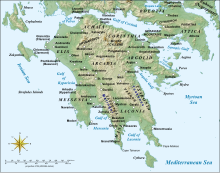
The Principality of Achaea or Principality of Morea was one of the three vassal states of the Latin Empire, which replaced the Byzantine Empire after the capture of Constantinople during the Fourth Crusade. It became a vassal of the Kingdom of Thessalonica, along with the Duchy of Athens, until Thessalonica was captured by Theodore, the despot of Epirus, in 1224. After this, Achaea became for a while the dominant power in Greece.

Centurione II Zaccaria, scion of a powerful Genoese merchant family established in the Morea, was installed as Prince of Achaea by Ladislaus of Naples in 1404 and was the last ruler of the Latin Empire not under Byzantine suzerainty.

Chlemoutsi, also known as Clermont, is a medieval castle in the northwest of the Elis regional unit in the Peloponnese peninsula of southern Greece, in the Kastro-Kyllini municipality.
John Chauderon was the Baron of Estamira and Grand Constable of the Principality of Achaea, the strongest of the principalities of Frankish Greece.

The Barony of Vostitsa was a medieval Frankish fiefdom of the Principality of Achaea, located in the northern coast of the Peloponnese peninsula in Greece, centred on the town of Vostitsa.

The Barony of Patras was a medieval Frankish fiefdom of the Principality of Achaea, located in the northwestern coast of the Peloponnese peninsula in Greece, centred on the town of Patras. It was among the twelve original baronies of the Principality of Achaea, but passed into the hands of the Latin Archbishop of Patras at about the middle of the 13th century. From 1337 on, it was an ecclesiastical domain independent of the Principality. It maintained close relations with the Republic of Venice, which governed the barony in 1408–13 and 1418. The barony survived until the Byzantine reconquest in 1429–30.

The Barony of Akova was a medieval Frankish fiefdom of the Principality of Achaea, located in the mountains of eastern Elis in the Peloponnese peninsula in Greece, centred on the fortress of Akova or Mattegrifon. It was among the twelve original baronies of Achaea, but was conquered by the Byzantines in 1320.

The Barony of Passavant or Passava was a medieval Frankish fiefdom of the Principality of Achaea, located in the mountains between the Mani peninsula and the plain of Laconia, in the Peloponnese peninsula in Greece, centred on the fortress of Passavant or Passava. It was among the twelve original baronies of the Principality of Achaea, but was conquered by the Byzantines in the early 1260s.

The Barony of Geraki was a medieval Frankish fiefdom of the Principality of Achaea, located on the western slopes of Mount Parnon in Laconia, of the Peloponnese peninsula in Greece, and centred on the castle of Geraki. After the fall of Geraki to the Byzantines, the ruling family, the Nivelets, retained their baronial title and were compensated with new lands in Messenia, as the Barony of Nivelet.

The Barony of Gritzena or Gritsena was a medieval Frankish fiefdom of the Principality of Achaea, located in eastern Messenia, in the Peloponnese peninsula in Greece, centred on the settlement of Gritzena.

The Barony of Kalavryta was a medieval Frankish fiefdom of the Principality of Achaea, located in the Peloponnese peninsula in Greece, centred on the town of Kalavryta.

The Barony of Karytaina or of Skorta was a medieval Frankish fiefdom of the Principality of Achaea, located in the Peloponnese peninsula in Greece, centred on the town of Karytaina in the mountainous region known as Skorta.

The Barony of Arcadia was a medieval Frankish fiefdom of the Principality of Achaea, located on the western coast of the Peloponnese peninsula in Greece, and centred on the town of Arcadia, ancient and modern Kyparissia.

The Barony of Chalandritsa was a medieval Frankish fiefdom of the Principality of Achaea, located in the northern Peloponnese peninsula in Greece, and centred on the town of Chalandritsa south of Patras.
Geoffrey of Briel, in older literature Geoffrey of Bruyères, was a French knight and the third lord of the Barony of Karytaina in the Principality of Achaea, in Frankish Greece. He led a colourful and turbulent life, narrated in detail in the Chronicle of the Morea. Accounted the finest knight in the Principality, he fought in the wars against the Byzantine Greeks, was captured in the Battle of Pelagonia in 1259, and was sent back to Achaea bearing the Byzantine terms in 1261. Geoffrey was twice deprived of his barony, once for rebelling against his uncle, the Prince of Achaea William II of Villehardouin, and then for abandoning the Principality without leave in order to spend time with a mistress, the wife of one of his feudatories, in Italy. He was pardoned both times, but henceforth held his title as a gift of the Prince. He died childless in 1275, and the Barony of Karytaina was split up.

Pontikokastro, known in French as Beauvoir and Italian as Belveder during the late Middle Ages, is a Byzantine castle in Agios Andreas, Katakolo, in the Peloponnese peninsula of Greece.
Andronikos Asen Zaccaria or Asanes Zaccaria was a Genoese lord of the Principality of Achaea in southern Greece.

The Battle of Saint George took place on 9 September 1320 between the Latin Principality of Achaea and the forces of the Byzantine governor of Mystras, at the fortress of Saint George in Skorta in Arcadia. As a result of the battle, Arcadia, the heartland of the Morea, came firmly under Byzantine control.
Erard I of Aulnay was Baron of Arcadia in the Principality of Achaea in the late 13th century.
Geoffrey Chauderon was the first Baron of Estamira and Grand Constable of the Principality of Achaea, in Frankish Greece.





